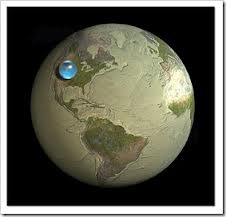By Brent Fewell
I love this picture – as it puts into perspective the importance of Earth’s finite water resources. The largest, blue sphere represents the total volume of all water on Earth. The medium size one over Kentucky represents all useable freshwater, including surface and groundwater. And the tiniest one over Atlanta, hardly visible, represents the amount of water in lakes and streams, the same water that gets recycled and filtered everyday through biological systems and has been available to sustain life for millions of years. It’s limited, that’s all there is. Just think, the water you drink from your tap was at one time filtered through the kidneys of dinosaur. Someone’s waste is another’s treasure or, in this case, water.
I had the opportunity this past week to spend a few days in Los Angeles at the U.S. Water Alliance’s One Water Leadership Summit. This four-day event spotlighted communities, like Los Angeles, San Francisco, Atlanta, Bend and Hillsboro OR, Kansas City, and Philadelphia, to name a few, who are working hard to fix intractable and very costly urban water pollution. Most don’t realize it, but urban rainwater remains one of the most significant and costly sources of water pollution in the U.S. today, costing hundreds of billions of dollars to cleanup. As the Academy of Public Administrators put it best in a 2010 report titled Taking Environmental Protection to the Next Level,
When we fertilize our lawns, drive our cars, wash our dishes, or go about our other daily routines, we contribute to making our streams, rivers, bays, and oceans unswimmable and toxic to marine life. The same potential arises as farmers grow the food we eat, when businesses dispose of the byproducts of their work, and when builders create new communities. In short, the necessities of life and pollution of our environment are inextricably linked.
My friend and former EPA boss, Ben Grumbles, President of U.S. Water Alliance, has been leading the band on promoting one water management – think stormwater, wastewater, and drinking water as a singularly important and integrated resource. Water in the U.S. has long been undervalued, due to historic mismanagement and subsidization, resulting in failing infrastructure, regional droughts, and environmental and economic stresses. There is a growing realization that water is not only vital for sustaining life, but is foundational to sustaining our economy. The U.S. Chamber of Commerce is so concerned about our emerging water challenges, they have a new campaign out called Water is Your Business. And the price tag to fix our crumbling water infrastructure – mostly underground and out of sight – is over a trillion  dollars.
dollars.
The fixes are costly, and at a time when many communities are struggling for their financial survival. Although the EPA often gets a bad rap for job-crushing regulations and enforcement, the is an area where the Agency is working to promote new, innovative and cost-effective solutions through “greening” our urban water infrastructure. For those unfamiliar with the term green infrastructure, the concept is pretty simple, relying upon mother nature rather than costly pipes, concrete, and chemical treatment solutions (a/k/a gray infrastructure) to clean up our waters. Historically, the approach has been to divert storm water runoff from roads, parking lots, sidewalks, roofs, and other impervious surfaces to the closest stream or wastewater treatment plant. This runoff not only carries pollutants (oil and grease, sediment, heavy metals from brake dust, pet waste and bacteria, fertilizers and pesticides) picked up along its journey to the nearest water body, but in some communities with combined sanitary and storm sewers, it overwhelms the treatment plants. One solution is to divert more urban rainwater into vegetated or forested areas, e.g., raingardens, green roofs, bioswales, and wetlands, to enhance rainwater percolation into the soils and recharge groundwater. And in areas, like Los Angeles, where water scarcity is increasing, using reclaimed wastewater for irrigation and industrial uses is increasingly becoming the norm.
water runoff from roads, parking lots, sidewalks, roofs, and other impervious surfaces to the closest stream or wastewater treatment plant. This runoff not only carries pollutants (oil and grease, sediment, heavy metals from brake dust, pet waste and bacteria, fertilizers and pesticides) picked up along its journey to the nearest water body, but in some communities with combined sanitary and storm sewers, it overwhelms the treatment plants. One solution is to divert more urban rainwater into vegetated or forested areas, e.g., raingardens, green roofs, bioswales, and wetlands, to enhance rainwater percolation into the soils and recharge groundwater. And in areas, like Los Angeles, where water scarcity is increasing, using reclaimed wastewater for irrigation and industrial uses is increasingly becoming the norm. 
During my trip, I had the chance to visit Echo Park, which the City has recently rehabilitated to help alleviate stormwater pollution. Now, a beautiful oasis in the middle of a concrete jungle, its functions are not only contributing to improved environmental quality, but the social and aesthetic values it provides to the surrounding community are truly special.
Here is a picture of my raingarden that I installed earlier this year, which has kept thousands of gallons of stormwater out of our local stream.


